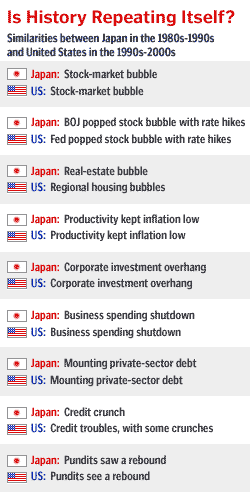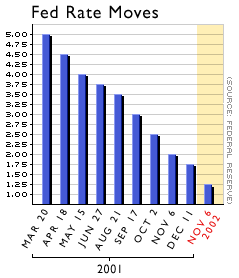NEW YORK (CNN/Money) -
When the Federal Reserve slashed interest rates this week, the central bank's policy-makers confidently claimed that the economy would get moving again, eventually, but they also probably had a nervous eye on the 800-pound gorilla lurking in the corner -- deflation.
The Fed cut its target for a key overnight bank lending rate by an aggressive half a percentage point Wednesday to a 40-year low of 1.25 percent in a bid to make borrowing cheaper and prod U.S. consumers to keep spending, and carrying the economy.
The policy-makers said they made the bigger-than-expected cut because of recent signs of economic weakness, a "soft spot" in an otherwise upward growth trajectory. But without mentioning it, the Fed almost certainly had to have another worry, deflation, in mind, some analysts said.

"The Federal Reserve is completely cognizant of deflationary tendencies in the system," said Van Hoisington, president and senior investment officer of Hoisington Investment Management. "We would not be surprised to see future aggressive policy moves by the Fed."
While most economists say the United States faces little real threat of deflation -- an unstoppable drop in prices that cripples corporate profits and economic growth -- there are clearly signs that price growth has slowed to a crawl.
For one thing, the gross domestic product (GDP) price index, a broad and closely watched measure of inflation, grew just 0.8 percent year-over-year in the third quarter of 2002 -- the lowest rate since the second quarter of 1950, according to Morgan Stanley chief economist Stephen Roach.
Meanwhile, a similar measure of prices for goods actually fell between the third quarter of 2001 and the third quarter of 2002, while price growth for services slowed considerably -- a process known as "disinflation," or declining inflation, not to be confused with "deflation," or falling prices -- in the same period, Roach said.
"An extraordinary deflationary shock in tradable goods has coincided with outsize disinflation in services, resulting in the most deflation-prone business cycle of the modern post-World War II era," Roach wrote in a research note.
But why care about deflation -- aren't falling prices a good thing? In some cases, they are. Productivity gains in the last century allowed businesses to make more goods more cheaply, lowering the price of those goods and improving everybody's standard of living.
But when prices fall simply because people have no desire to buy -- leading to a vicious cycle of consumers postponing spending because they believe prices will fall further -- then businesses can't make a profit or pay off their debts, leading them to cut production and workers, leading to lower demand for goods, which leads to even lower prices. Wash. Rinse. Repeat.
In other words, the Four Horsemen of the economic Apocalypse will be saddling up.

For example, deflation has crippled Japan's economy, the world's second-largest, since the mid-1990s, severely worsening that nation's post-boom recession.
Many pundits pooh-pooh efforts to compare the United States to Japan, saying the deflationary death spiral that crippled Japan could never do the same thing to the world's biggest economy, in the United States.
Though it's true that there are important fundamental differences between the two nations, there are plenty of alarming similarities. Both had large asset-price bubbles, both had central banks that raised interest rates and popped those bubbles, both had companies and households saddled with debt, and both suffered from a period when companies overspent followed by a period of miserly corporate investment.
"There is much to learn from Japan," Dresdner Kleinwort Wasserstein global strategist Albert Edwards said in a research note. "It is not Mars."
The Fed itself has indicated it's aware of the similarities; in June, it published a study about deflation in Japan and how monetary policy could have prevented it.
The study said deflation can be avoided with more aggressive monetary policy action when inflation and interest rates are near zero. Japan's deflation could have been dodged, for example, if the Bank of Japan (BOJ) had only cut interest rates by 2 more percentage points between 1991 and 1995, it said.
"Too much stimulus can be taken back later through a corrective tightening of policies," the study said. "However, if too little stimulus is provided and the economy moves into deflation, the future ability of monetary policy to pull the economy out of its slump can be substantially undermined."
The study said that, while the BOJ's target for rates in the early 1990s seemed perfectly reasonable and perhaps even too stimulative, the central bank should have been more worried about the possibility of downside risks and loosened its policy even more.
In light of that conclusion, the Fed's decision Wednesday certainly has the feel of deflation insurance.
"You don't need the specter of deflation to provide an excuse for why the Fed cut, but I think it was lurking in the background and is one of the reasons we're seeing quite an aggressive Fed," said Doug Porter, senior economist at BMO Nesbitt Burns.
Certainly the Fed noted back in September that there was a risk of super-low inflation hampering their ability to help the economy pull out of a recession.
"[F]urther sizable disinflation that resulted in a nominal inflation rate near zero could create problems for the implementation of monetary policy through conventional means," the minutes of the Fed's Sept. 24 policy meeting said.
The lower inflation is, the harder it is to move interest rates below inflation to make hoarding money undesirable, a common central bank trick to encourage spending.
In fact, some economists speculated that it was possible the Fed might have made its big cut Wednesday and pretended to close up shop in order to force people to take advantage of low rates now, rather than sit around waiting for another small rate cut in December.
Of course, that might be reading way too much into the Fed's decision -- a fun thing to do on Wall Street and in newsrooms, but perhaps a touch removed from reality.
"The Fed's not as devious or fickle as the market thinks," said Bank of America chief economist Mickey Levy. "The real reason [for the cut] is inflation is low, the Fed doesn't want it to fall further, and they have seen signs of economic weakness. Beyond that, it's overanalyzing things."

|

